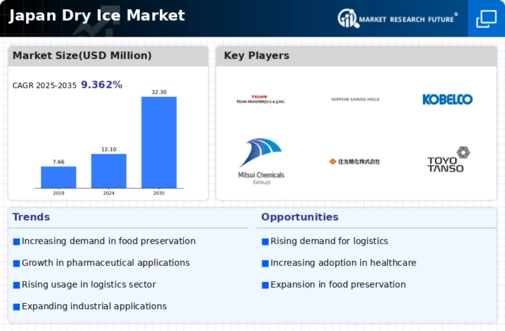Growth in E-commerce Logistics
The expansion of e-commerce logistics in Japan is a pivotal driver for the dry ice market. As online shopping continues to gain traction, the need for efficient cold chain solutions becomes increasingly critical. Dry ice serves as an effective refrigerant for shipping perishable goods, ensuring product integrity during transit. In 2025, the e-commerce sector in Japan is projected to reach approximately $200 billion, with a substantial portion of this growth attributed to food and pharmaceutical deliveries. This surge in demand for reliable shipping methods is likely to bolster the dry ice market, as companies seek to maintain quality and safety standards in their deliveries.
Rising Awareness of Food Safety
The increasing awareness of food safety among consumers is a crucial driver for the dry ice market. In Japan, where food quality is paramount, the use of dry ice in food preservation and transportation is becoming more prevalent. In Japan, where food quality is paramount, the use of dry ice in food preservation and transportation is becoming more prevalent. The market is projected to grow as businesses adopt dry ice solutions to comply with stringent food safety regulations. In 2025, the food safety market in Japan is estimated to be valued at over $10 billion, with a significant portion dedicated to cold chain logistics. This heightened focus on food safety is likely to propel the demand for dry ice, as it plays a vital role in maintaining the cold chain.
Expansion of the Pharmaceutical Sector
The expansion of the pharmaceutical sector in Japan is a significant driver for the dry ice market. As the industry continues to grow, the need for effective temperature-controlled logistics becomes increasingly important. Dry ice is essential for the transportation of temperature-sensitive medications and vaccines, ensuring their efficacy during transit. The pharmaceutical market in Japan is projected to reach approximately $100 billion by 2025, with a substantial portion of this growth attributed to the demand for reliable cold chain solutions. This trend is likely to enhance the dry ice market, as pharmaceutical companies seek to maintain product integrity.
Technological Advancements in Production
Technological advancements in the production of dry ice are significantly influencing the market dynamics. Innovations in manufacturing processes have led to increased efficiency and reduced costs, making dry ice more accessible to various industries. In Japan, the dry ice market is expected to witness a growth rate of around 5% annually, driven by these advancements. Enhanced production techniques not only improve the quality of dry ice but also allow for better scalability to meet rising demand. As industries such as food processing and pharmaceuticals continue to evolve, the dry ice market is likely to benefit from these technological improvements.
Increased Focus on Environmental Sustainability
The increased focus on environmental sustainability is influencing the dry ice market in Japan. As businesses strive to reduce their carbon footprint, dry ice is emerging as a more eco-friendly alternative to traditional refrigerants. Its ability to sublimate without leaving any residue makes it an attractive option for companies looking to adopt sustainable practices. In 2025, the market for sustainable packaging solutions in Japan is expected to grow by 8%, with dry ice playing a pivotal role in this transition. This shift towards sustainability is likely to drive demand for dry ice, as industries seek to align with consumer preferences for environmentally responsible products.





















Leave a Comment